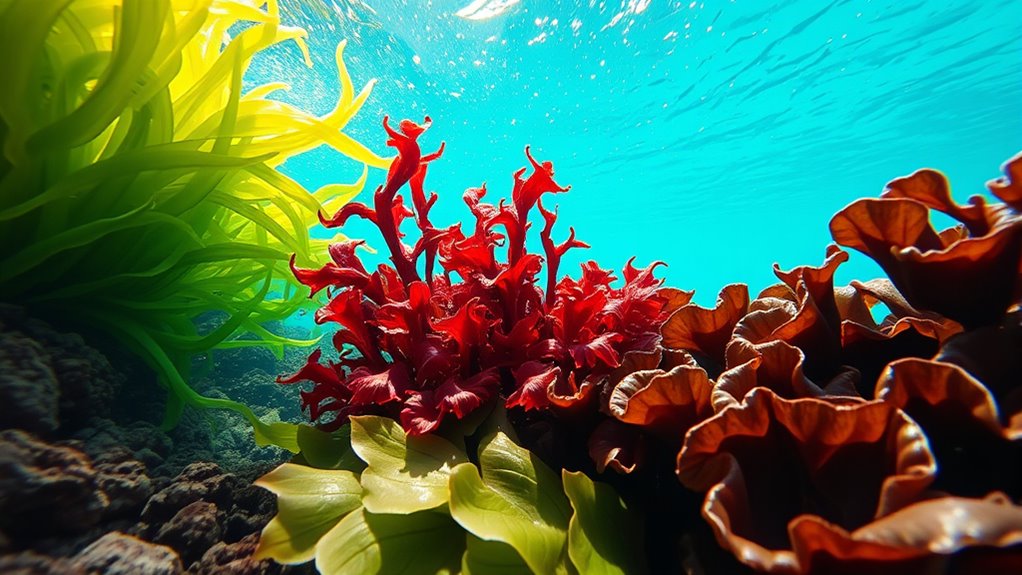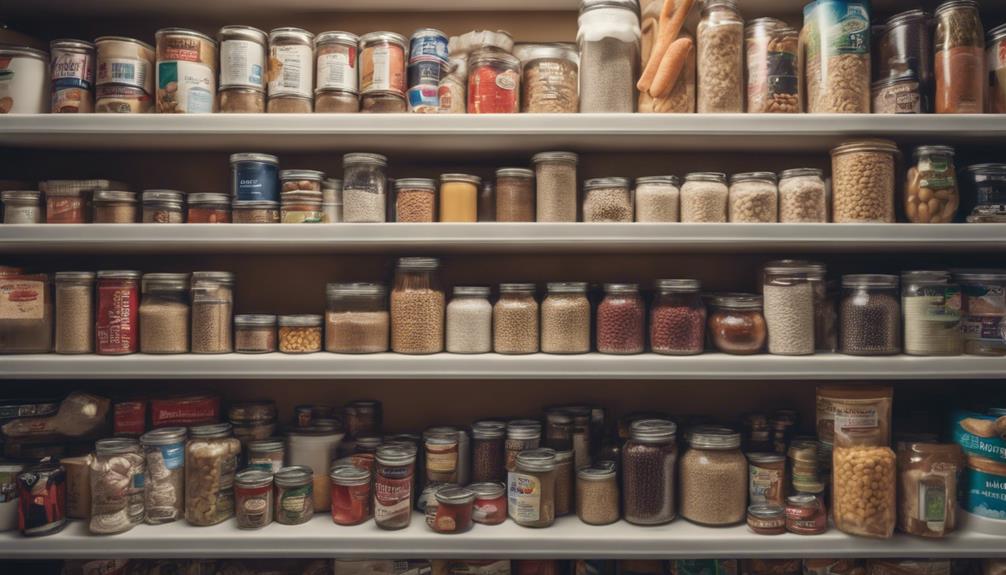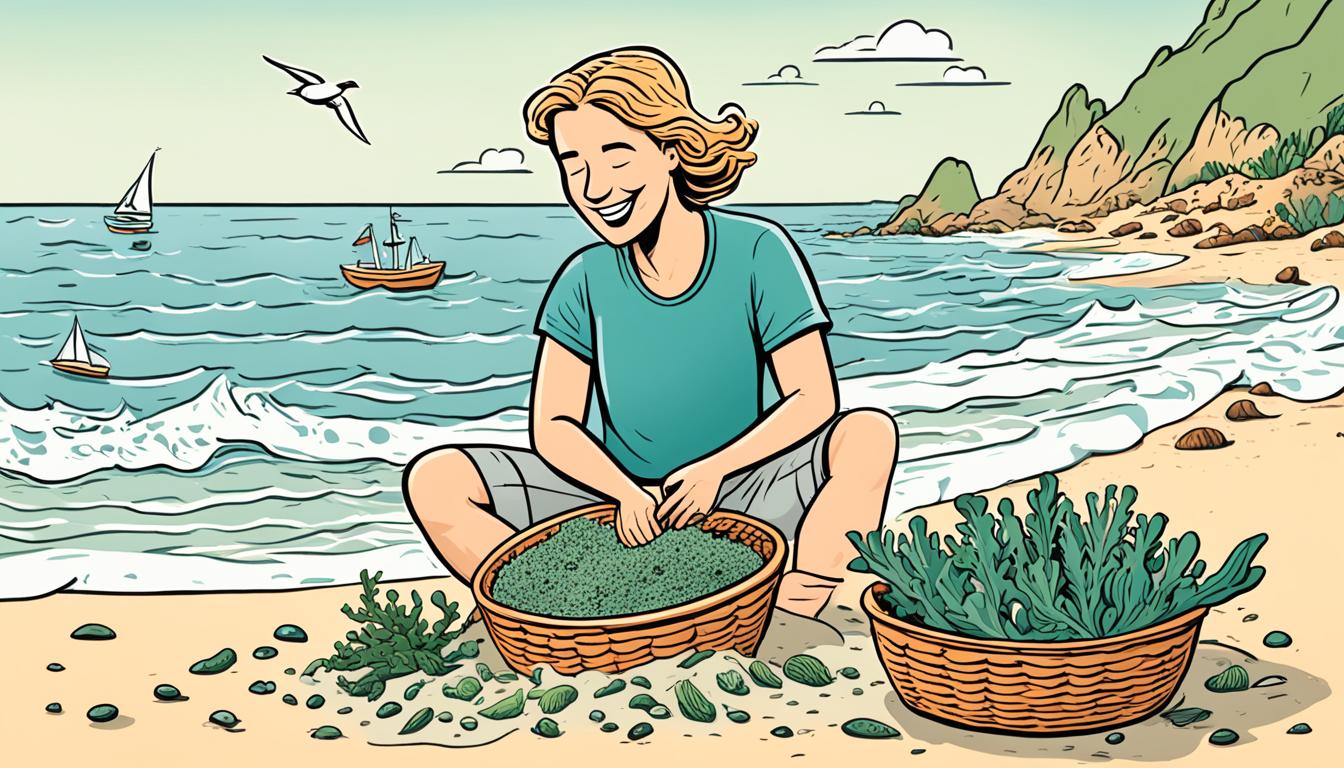To identify edible seaweeds, look for species like dulse with reddish, finger-like fronds, or sea lettuce with bright green, delicate leaves. Notice their habitat — attached to rocks in tidal zones — and seasonality, with peak harvest from January to May. Observe their shape, texture, and color, and avoid plants from polluted areas. To guarantee safety, learn to distinguish edible varieties from toxic look-alikes—more tips will help you confidently forage and enjoy seaweeds safely.
Key Takeaways
- Recognize common edible seaweeds by their distinct shapes, colors, textures, and growth habitats, such as dulse’s finger-like fronds or wakame’s broad leaves.
- Identify seaweeds based on their typical habitat zones and seasonal timing, with peak harvest from January to May in clean, low-tide areas.
- Use tidal charts and observe weather conditions to harvest during calm, low spring or autumn tides for safety and quality.
- Differentiate safe edible species from look-alikes by consulting trusted field guides, noting features like coloration, texture, and attachment sites.
- Ensure seaweed freshness by avoiding polluted areas, inspecting for signs of spoilage, and handling with clean tools to prevent health risks.
Recognizing Common Edible Seaweeds by Appearance

To recognize common edible seaweeds by appearance, start by observing their color, shape, and texture. Different seaweeds have distinct looks that help you identify them as edible. For instance, Dulse appears as reddish, finger-shaped fronds that are soft and pliable when fresh, with a salty, umami flavor. Sea Lettuce is bright green, resembling small, crinkled lettuce leaves, and often forms dense mats on rocks. Sugar Kelp has long, ribbon-like fronds with a yellow-brown hue, featuring wavy edges and a tough texture when mature. By paying attention to these features—color, shape, and texture—you can accurately identify edible seaweed in the wild. Recognizing these key visual signs makes for safe foraging and ensures you collect the right species. Additionally, understanding the role of color accuracy can help distinguish edible varieties from potentially harmful look-alikes. Being familiar with species-specific features also enhances safe identification and helps prevent accidental harvesting of inedible or toxic seaweeds. Furthermore, paying close attention to the habitat and growth patterns of each species can provide additional clues for correct identification. Seasonal variations can also influence the appearance and abundance of certain seaweeds, making them easier or more challenging to identify at different times of the year.
Understanding the Habitat and Growth Patterns of Seaweeds
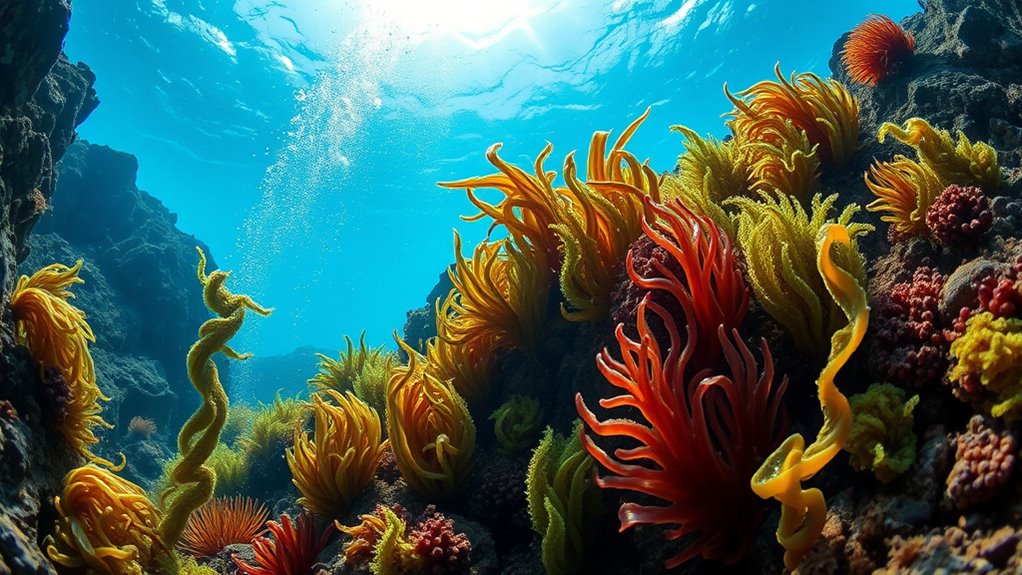
Have you ever wondered why certain seaweeds grow in specific areas along the shoreline? It’s because each species prefers particular habitats within rocky shorelines and tidal zones. Green seaweeds often thrive higher on the shore, where they tolerate more exposure, while brown species prefer deeper, submerged areas with calmer waters. Water temperature plays a role, with colder UK waters supporting larger, sturdier marine species. Strong currents and wave action boost nutrient flow, leading to bigger, tastier seaweeds. Many attach to rocky substrates using holdfasts, some even growing on other seaweeds. Seasonal growth also influences distribution; from January to May, edible species are most abundant and accessible, thanks to active growth during this period. Additionally, understanding habitat preferences helps in sustainable harvesting and conservation efforts. Recognizing the growth patterns of different seaweed species can also aid in identifying optimal harvesting times and locations. Furthermore, knowledge of environmental factors can assist in predicting changes in seaweed distribution due to climate variations.
Seasonal Timing and Optimal Harvest Periods
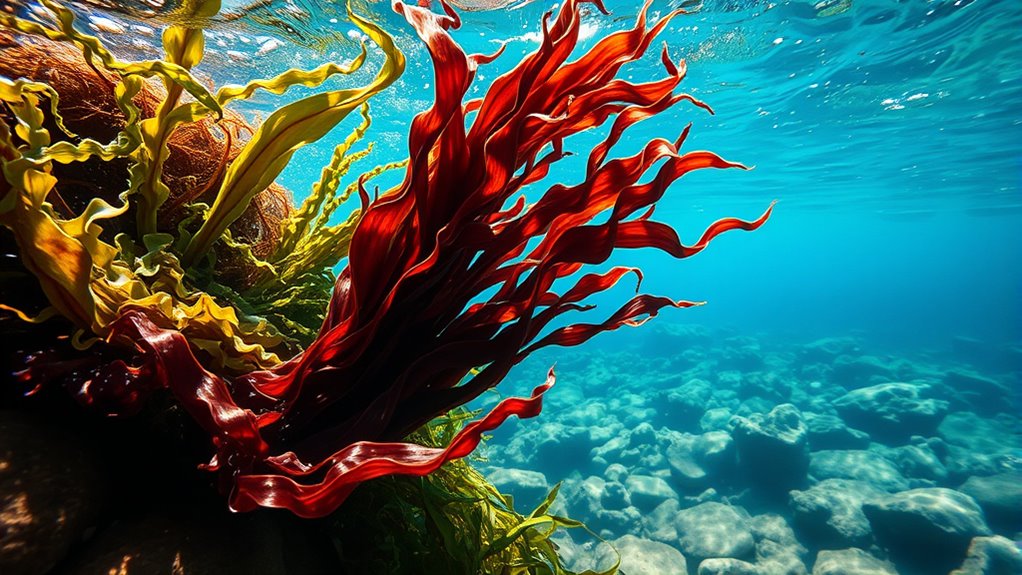
Timing your harvest is essential for getting the best flavor and nutrition from seaweeds. You’ll want to focus on late winter to early summer, avoiding warmer months when water quality dips. Keep an eye on tides and weather, as low spring or autumn tides often offer the most abundant and pristine seaweed. Additionally, understanding seasonal fluctuations can help you identify the optimal periods for harvesting healthy and nutrient-rich seaweeds. Recognizing seaweed growth patterns can further enhance your harvest timing, ensuring you collect during peak nutrient availability. Monitoring environmental conditions such as water temperature and nutrient levels can also improve the quality of your harvest.
Peak Harvest Seasons
The ideal time to harvest edible seaweeds in the UK is from January to May, when they are most abundant, nutritious, and at their best flavor. During this peak harvest season, seaweeds are seasonally available and at their highest quality, especially in early spring. Harvesting during this period guarantees you collect them when they’ve reached maximum size and flavor, avoiding the spawning months from May to September. Visualize the abundance with this imagery:
| Winter | Early Spring | Late Spring |
|---|---|---|
| Cold waters | Peak harvest | Shift period |
| Nutrient-rich | Best flavor | Spawning begins |
| Abundant growth | High quality | Decline begins |
Timing your harvest within this window guarantees the freshest, most vibrant seaweeds for culinary use. Additionally, understanding the seasonal timing of seaweed growth can help ensure sustainable harvesting practices. Recognizing the biological cycles of seaweeds is essential for maintaining healthy populations and preventing overharvesting. Being aware of growth patterns can further support sustainable collection and help protect marine ecosystems. Incorporating knowledge of seaweed ecology can enhance sustainable harvesting techniques and promote marine conservation efforts.
Tidal and Weather Factors
Maximizing your seaweed harvest depends heavily on understanding tidal patterns and weather conditions. To optimize your harvest, consider these key factors:
- Tidal cycles: Target super-low tides, usually 1-2 days after the full moon in spring and autumn, for maximum exposure. Tidal cycles influence the timing and accessibility of seaweeds for harvest. Planning around tidal schedules ensures you harvest when seaweeds are most accessible and abundant.
- Seasonal timing: The best months are January to May, when seaweeds are nutrient-rich, while avoiding spawning months from May to September. The influx of nutrients during these months enhances seaweed quality.
- Weather conditions: Harvest after calm, clear days, as storms and heavy rainfall can wash up or damage seaweeds, reducing quality and safety. Monitoring weather patterns helps ensure safe and productive harvesting conditions. Additionally, stable weather during harvest minimizes the risk of contaminated or unsafe seaweeds.
- Market trends can also influence the best times to harvest, as demand for certain seaweeds may peak during specific periods, ensuring a more profitable collection. Additionally, understanding local demand can help plan your harvest schedule more effectively. Keeping an eye on consumer preferences can help you align your harvest with market needs.
Differentiating Between Safe and Potentially Toxic Species

While all edible seaweeds in UK waters are considered safe, correctly identifying them is vital to avoid confusion with potentially toxic species. Some red algae may resemble toxic varieties, so learning key visual features is essential for proper identification. Always be cautious; avoid harvesting seaweeds from polluted areas like stagnant water, busy harbors, or ports, as these can contain toxins or pollutants that compromise safety. Never consume seaweeds that look brown or slimy, as these signs often indicate spoilage or inedibility. To guarantee harvesting safety, if you’re unsure about a species, consult experienced foragers or marine biologists. Accurate identification helps prevent accidental ingestion of harmful look-alikes and ensures you enjoy safe, edible seaweeds from UK waters. Additionally, understanding emergency preparedness essentials can help ensure safety during foraging trips in unpredictable environments. Being aware of the factors that influence seaweed safety can further enhance your confidence in harvesting edible species responsibly, especially since some edible red algae may resemble toxic species, emphasizing the importance of proper recognition skills.
Key Identification Features of Popular Edible Varieties

To identify edible seaweeds, focus on their leaf shape and texture, as these features vary among varieties. Pay attention to their color and pigmentation, which can range from reddish to dark green or brown, indicating different species. Additionally, note their growth habitats and zones, since many thrive attached to rocks or in specific marine environments. Recognizing seasonal variations can also aid in proper identification, as some species are more abundant during certain times of the year. Being aware of marine environment preferences further helps distinguish edible varieties from potentially inedible or toxic ones.
Leaf Shape and Texture
Edible seaweeds can be identified by their distinct leaf shapes and textures, which vary considerably across species. Recognizing these features is key to accurate seaweed identification.
- Some species, like Wakame, have broad, flat leaf shapes that are easy to spot.
- Others, such as Dulse, feature finger-like fronds with a slightly leathery texture.
- Green seaweeds like Sea Lettuce display thin, ruffled, and delicate leaf textures, contrasting with the tougher, leathery leaves of brown varieties like Kombu.
Color and Pigmentation
Color and pigmentation are prominent features that help distinguish between different edible seaweed species. Your observation of color can reveal their adaptation to water depth and light conditions. Green seaweeds like Sea Lettuce (Ulva spp) are bright green due to high chlorophyll, thriving in shallow intertidal zones. Brown seaweeds such as Kelp (Laminaria spp) appear darker because of pigments like fucoxanthin, which mask chlorophyll and suit deeper waters. Red seaweeds like Dulse (Palmaria palmata) display vivid red or purple hues from phycoerythrin, enabling light absorption at greater depths. Here’s a visual guide:
| Color | Key Pigmentation | Typical Species |
|---|---|---|
| Green | Chlorophyll | Ulva spp |
| Brown | Fucoxanthin, carotenoids | Laminaria spp |
| Red | Phycoerythrin | Palmaria palmata |
Growth Habitats and Zones
Understanding the growth habitats and zones of edible seaweeds is essential for accurate identification and sustainable harvesting. Tidal zones influence where different species thrive; green seaweeds like sea lettuce grow higher on the shore, red varieties such as Irish moss appear in the lower intertidal, and brown kelp prefers deeper subtidal waters. Many species grow attached to rocks via holdfasts, helping you distinguish them from free-floating algae. Water movement also shapes habitat choices—larger brown algae favor strong currents and exposed coasts, while delicate species prefer sheltered areas. Recognizing these habitat features, including wave action, substrate, and water depth, guides you to the right zones for harvesting and ensures you gather sustainably. By understanding these zones, you improve your seaweed identification skills and protect marine ecosystems.
Tools and Techniques for Accurate Seaweed Collection

To guarantee you collect seaweeds accurately and sustainably, it’s essential to use the right tools and techniques. Start with sturdy, sharp scissors or a knife to cut seaweeds at the base, avoiding pulling or tearing, which can damage the holdfasts and habitat. Familiarize yourself with tidal charts and lunar phases to harvest during ideal low tides, usually 1-2 days after a full moon, when seaweeds are more exposed. Collect only live, attached seaweeds from clean, pollution-free waters—steer clear of washed-up or storm-damaged specimens. To identify species correctly, observe their color, shape, and habitat zone, and cross-reference with reliable field guides or digital resources. Handle everything gently, using clean tools and containers to minimize ecosystem disturbance.
Tips for Avoiding Overharvesting and Protecting Ecosystems

To protect seaweed populations and maintain healthy ecosystems, it’s crucial to harvest responsibly. Practicing sustainable harvesting ensures the longevity of seaweed beds and preserves biodiversity. Here are key tips:
Harvest responsibly to preserve seaweed populations and maintain healthy, thriving ecosystems.
- Only take the top third of a seaweed colony to allow for regrowth.
- Rotate harvesting locations regularly to prevent overexploitation and support ecosystem diversity.
- Follow local regulations and guidelines to ensure sustainable harvesting practices.
Using scissors or knives instead of pulling seaweeds minimizes habitat disturbance and protects attached organisms. Avoid collecting rare or sensitive species to prevent disrupting unique habitats. By adhering to these practices, you help sustain healthy ecosystems and ensure that seaweed populations thrive for future harvests. Responsible harvesting not only benefits the environment but also supports the long-term viability of edible seaweeds.
Processing and Preparing Freshly Gathered Seaweeds

After gathering your seaweeds, it’s important to prepare them properly to preserve their quality and flavor. Start by rinsing them thoroughly in seawater to remove sand, salt, and small organisms—never use fresh water, as it damages delicate tissues. Gently pat the seaweeds dry with a clean cloth or paper towel to prevent excess moisture. For processing, cut larger or tougher seaweeds into smaller pieces or strips to improve drying and storage. To dry, spread the seaweeds in a single layer on a clean surface or use a dehydrator at low temperatures to retain nutrients. Proper storage involves airtight, labeled containers kept away from light and humidity to maintain freshness and prevent mold.
| Step | Method | Tips |
|---|---|---|
| Rinsing | Seawater rinse | Avoid fresh water |
| Drying | Air drying or dehydrator | Preserve nutrients |
| Cutting | Smaller pieces for efficiency | Easier processing |
| Storage | Airtight containers | Keep in cool, dark places |
| Processing | Remove excess moisture | Prevent spoilage |
Incorporating Seaweeds Into Cooking and Recipes

Incorporating seaweeds into your cooking offers a simple way to boost both flavor and nutrition. Whether you’re making seaweed salads, broths, or miso soup, seaweeds add depth and mineral-rich umami. Here are three ways to incorporate them seamlessly:
- Rehydrate dried seaweeds like wakame or Irish moss in water for 10–15 minutes before adding to salads, stews, or stir-fries.
- Use dried seaweed powders such as kelp or dulse in smoothies, sauces, or bread dough for flavor and added minerals.
- Add fresh sea lettuces or dulse as toppings for baked dishes or wraps, bringing a savory, mineral-rich element to your meals.
These methods make incorporating seaweeds into everyday recipes easy and delicious.
Frequently Asked Questions
How Can I Tell if a Seaweed Is Freshly Harvested and Safe to Eat?
To tell if a seaweed is freshly harvested and safe to eat, look for vibrant, bright colors and a firm texture, not slimy or dull. Check for a clean smell, like the ocean, without any sour or fishy odors. confirm it’s free of dirt and debris, and avoid seaweeds that appear discolored or have a slimy coating. Fresh seaweed should feel crisp and smell fresh, indicating it’s safe for consumption.
Are There Specific Regulations or Permits Required for Seaweed Harvesting Locally?
You should check with local authorities or environmental agencies to see if any permits or regulations apply to seaweed harvesting in your area. Many regions require permits to ensure sustainable practices and protect marine ecosystems. Contact your local wildlife or marine resource department, or visit their website, to find specific rules. Failing to follow these regulations could result in fines or environmental harm, so always stay informed before harvesting.
Can Seaweeds Be Harvested Sustainably Without Harming the Ecosystem?
Think of sustainable seaweed harvesting as tending a delicate garden in the ocean. You can do it without harming the ecosystem by following best practices like avoiding overharvesting, respecting marine life, and choosing harvest areas carefully. Using responsible methods guarantees the ocean’s bounty remains abundant for future generations. So, yes, you can harvest seaweed sustainably, turning you into a steward of the sea rather than its adversary.
What Are Common Mistakes Beginners Make When Identifying Edible Seaweeds?
When identifying edible seaweeds, you might mistake toxic varieties for safe ones or overlook key features like color, texture, or shape. Beginners often rush, not double-checking identification guides or ignoring habitat cues. You should take your time, verify each specimen carefully, and learn from experienced foragers. Remember, misidentification can be dangerous, so always err on the side of caution and confirm you’re confident before harvesting any seaweed.
How Do I Store and Preserve Seaweeds After Harvesting for Later Use?
After harvesting seaweed, you should rinse it thoroughly to remove salt and debris. Then, dry it in a well-ventilated area or use a dehydrator to preserve its flavor and nutrients. Store the dried seaweed in airtight containers away from direct sunlight to prevent spoilage. When you’re ready to use it, rehydrate by soaking in water if desired. Proper storage keeps your seaweed fresh and flavorful for future meals.
Conclusion
Now that you know how to identify safe, edible seaweeds, you’re ready to explore their culinary potential. But remember, just like the ocean’s vast beauty, its dangers lurk beneath the surface. With careful harvesting and respect for nature, you can enjoy these nutritious treasures without harm. Immerse yourself in your seaweed journey confidently—where the thrill of discovery meets the responsibility of preservation. Embrace the adventure, but stay vigilant and respectful of the ocean’s delicate balance.

